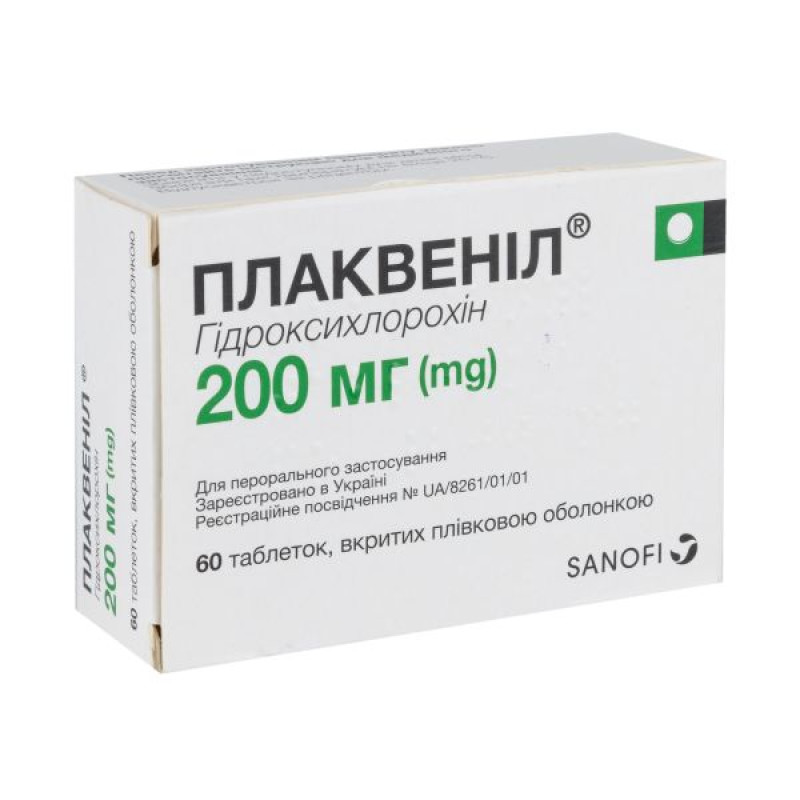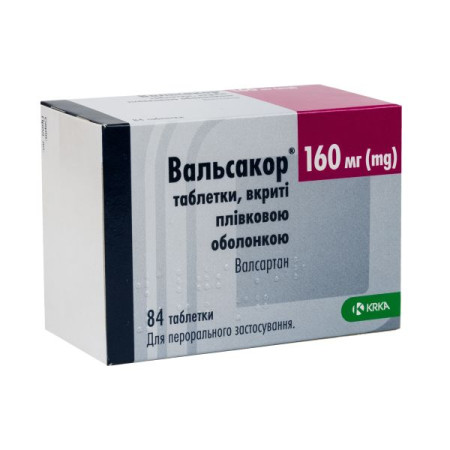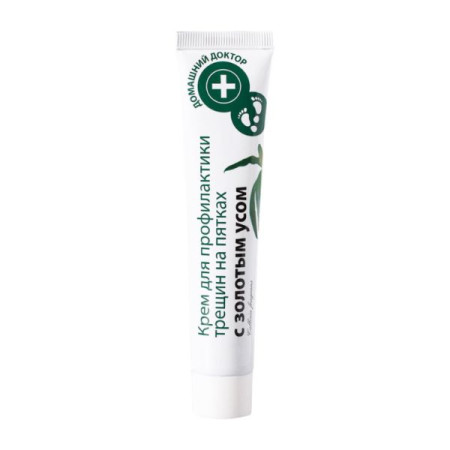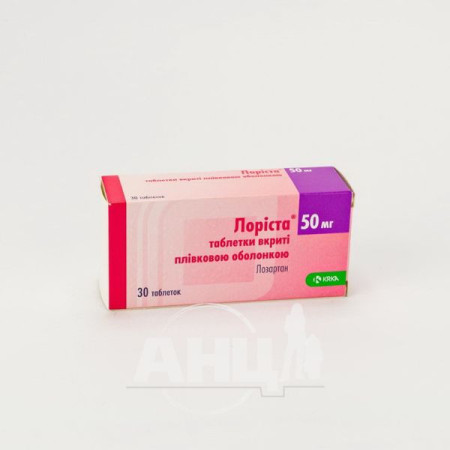Plaquenil film-coated tablets 200 mg blister No. 60

Instructions Plaquenil film-coated tablets 200 mg blister No. 60
Composition
active ingredient: hydroxychloroquine;
1 tablet contains hydroxychloroquine sulfate 200 mg;
excipients: lactose monohydrate, povidone, corn starch, magnesium stearate; shell: Opadry OY-L-28900 (hypromellose, titanium dioxide (E 171), polyethylene glycol, lactose monohydrate).
Dosage form
Film-coated tablets
Main physicochemical properties: white, biconvex, film-coated tablets with flat edges, marked “HCQ” on one side and “200” on the other.
Pharmacotherapeutic group
Antiparasitic drugs. Antimalarials. Aminoquinolines. Hydroxychloroquine. ATC code P01B A02.
Pharmacological properties
Pharmacodynamics
Antimalarial drugs such as chloroquine and hydroxychloroquine exert several pharmacological actions that contribute to their therapeutic effects in the treatment of rheumatic diseases, although the role of each of these mechanisms remains unknown. These effects include interactions with sulfhydryl groups, alteration of enzyme activities (including phospholipases, NADH-cytochrome C reductase, cholinesterases, proteases, and hydrolases), DNA binding, stabilization of lysosomal membranes, inhibition of prostaglandin production, inhibition of chemotaxis and phagocytosis of polymorphonuclear cells, possible effects on monocyte interleukin-1 production, and inhibition of neutrophil superoxide release.
Pharmacokinetics
Absorption
After oral administration, peak blood or plasma concentrations are reached in approximately 3–4 hours. The mean absolute bioavailability after oral administration in the fasted state is 79% (SD 12%). Food intake does not affect the oral bioavailability of hydroxychloroquine.
Distribution
Hydroxychloroquine has a large volume of distribution (5,500 L in blood, 44,000 L in plasma) due to extensive tissue accumulation (such as eyes, kidneys, liver, and lungs) and exhibits accumulation in blood cells with a whole blood to plasma ratio of 7.2. Approximately 50% of hydroxychloroquine is bound to plasma proteins.
Metabolism
Hydroxychloroquine is primarily metabolized to N-desethylhydroxychloroquine and two other metabolites shared with chloroquine, desethylchloroquine and bis-acetylchloroquine. In vitro, hydroxychloroquine is metabolized primarily by CYP2C8, CYP3A4, and CYP2D6, as well as FMO-1 MAO-A without significant involvement of a single CYP or enzyme.
Elimination
Hydroxychloroquine has a multistep elimination profile with a long terminal half-life of 30 to 50 days. Approximately 20-25% of the hydroxychloroquine dose is excreted in the urine as unchanged drug. After repeated oral administration of hydroxychloroquine sulfate at doses of 200 mg and 400 mg once daily to adult patients with lupus or rheumatoid arthritis, mean steady-state blood concentrations were 450-490 ng/mL and 870-970 ng/mL, respectively.
The pharmacokinetics of hydroxychloroquine are linear in the therapeutic dose range of 200 to 500 mg per day.
Pharmacokinetic interactions
Effects of hydroxychloroquine on other drugs
In vitro, hydroxychloroquine has no potential to inhibit CYP1A2, CYP2B6, CYP2C8, CYP2C9, and CYP2C19. Hydroxychloroquine inhibits CYP2D6 and CYP3A4 in vitro. An interaction study has shown that hydroxychloroquine is a weak inhibitor of CYP2D6 (see section 4.5).
In vitro, hydroxychloroquine has no significant potential to induce CYP1A2, CYP2B6, and CYP3A4. In vitro, hydroxychloroquine did not significantly inhibit the major transporters BCRP, OATP1B1, OATP1B3, OAT1, and OAT3. Hydroxychloroquine inhibited P-glycoprotein at high concentrations (see Interactions with other medicinal products and other forms of interaction). In vitro, hydroxychloroquine has the potential to inhibit the transporters OCT1, OCT2, MATE1, and MATE2-K.
Kidney dysfunction
Renal impairment is not expected to significantly alter the pharmacokinetics of hydroxychloroquine in patients with renal impairment, as hydroxychloroquine is extensively metabolized and only 20-25% of a hydroxychloroquine dose is excreted unchanged in the urine. Hydroxychloroquine exposure may be increased by 46% in patients with moderate to severe renal impairment (see section 4.4).
Liver dysfunction
The effect of hepatic impairment on the pharmacokinetics of hydroxychloroquine has not been evaluated in a dedicated pharmacokinetic study. Given that hydroxychloroquine is extensively metabolized, increased exposure to hydroxychloroquine is expected in patients with hepatic impairment (see section 4.4).
Elderly patients
Limited data available in elderly patients with rheumatoid arthritis suggest that hydroxychloroquine exposure remains in the same range as in younger patients.
Children
The pharmacokinetics of hydroxychloroquine in children (under 18 years of age) have not been studied.
Preclinical safety data
Genotoxicity/carcinogenicity
Based on the studies conducted, no genotoxicity of hydroxychloroquine has been detected. There are no relevant non-clinical studies on the carcinogenicity of hydroxychloroquine.
Hydroxychloroquine crosses the placenta. In studies in mice and monkeys, which do not involve compliance with good laboratory practice, it has been demonstrated that transplacental transfer of chloroquine, a derivative of hydroxychloroquine, occurs with accumulation in fetal eye and ear tissues. High doses of chloroquine administered to pregnant rats have been shown to be fetotoxic and have caused anophthalmia and microphthalmia. Studies in rats have shown that chloroquine reduces testosterone secretion, testicular and epididymal weight, and leads to an increase in the number of abnormal sperm.
Indication
Adults
Treatment of rheumatoid arthritis, discoid and systemic lupus erythematosus, as well as dermatological diseases caused or aggravated by sunlight.
Pediatric population
Treatment of juvenile idiopathic arthritis (in combination with other drugs), discoid and systemic lupus erythematosus.
Contraindication
Known hypersensitivity to 4-aminoquinoline compounds.
Maculopathy diagnosed before starting treatment with Plaquenil®.
Age less than 6 years (200 mg tablets are not suitable for use in patients with a body weight < 35 kg) or ideal body weight < 31 kg (see section "Method of administration and dosage").
Interaction with other medicinal products and other types of interactions
Pharmacodynamic interactions
Medicinal products with known QT prolongation/potential to cause cardiac arrhythmias. Hydroxychloroquine should be used with caution in patients receiving medicinal products known to prolong the QT interval, such as class IA and III antiarrhythmics, tricyclic antidepressants, antipsychotics, certain anti-infectives (antibacterials such as fluoroquinolones such as moxifloxacin, macrolides such as azithromycin, antiretrovirals such as saquinavir, antifungals such as fluconazole, antiparasitics such as pentamidine), due to an increased risk of ventricular arrhythmia (see sections 4.4, 4.8 and 4.8). Halofantrine should not be administered concomitantly with hydroxychloroquine.
Since hydroxychloroquine may potentiate the effect of hypoglycemic treatment, a reduction in the dose of insulin or antidiabetic agents may be required (see also “Hypoglycemia” in the “Special warnings and precautions for use” section and the “Adverse reactions” section).
Concomitant use of hydroxychloroquine and antimalarial drugs known to lower the seizure threshold (e.g. mefloquine) may increase the risk of seizures (see section 4.8).
The effectiveness of antiepileptic drugs may be reduced when used concomitantly with hydroxychloroquine.
If possible, the concomitant use of the drug with drugs that have oculotoxic (see also “Retinopathy” in the “Special Instructions” section) or hemotoxic potential should be avoided due to the potential additive effect (see “Adverse Reactions” section).
There is a theoretical risk of inhibition of intracellular α-galactosidase activity when hydroxychloroquine and agalsidase are used concomitantly.
Hydroxychloroquine sulfate may also interact with some of the interactions known for chloroquine, even though no specific reports have been received. These include: enhancement of the direct blocking effect of aminoglycoside antibiotics at the neuromuscular synapse; antagonism of the effects of neostigmine and pyridostigmine; and reduction of antibody production in response to primary immunization with intradermal human diploid cell rabies vaccine.
Pharmacokinetic interactions
Effects of other drugs on hydroxychloroquine
Antacids and kaolin
Concomitant use with magnesium-containing antacids or kaolin may result in reduced absorption of chloroquine. Therefore, based on extrapolation, hydroxychloroquine should be administered separately from antacids and kaolin, with an interval of at least two hours.
CYP inhibitors or inducers
In vitro, hydroxychloroquine is metabolized primarily by CYP2C8, CYP3A4, and CYP2D6 without significant involvement of any individual CYP. Concomitant use of cimetidine, a nonselective CYP inhibitor, resulted in a twofold increase in chloroquine exposure. In the absence of in vivo drug interaction studies, caution (e.g., monitoring for adverse effects) is recommended when cimetidine or strong inhibitors of CYP2C8 and/or CYP3A4 or CYP2D6 (such as gemfibrozil, clopidogrel, ritonavir, itraconazole, clarithromycin, grapefruit juice, fluoxetine, paroxetine, quinidine) are co-administered.
Hydroxychloroquine has been reported to be ineffective when co-administered with rifampicin, a strong inducer of CYP2C8 and CYP3A4. Caution (e.g., monitoring of efficacy) is recommended when co-administered with strong inducers of CYP2C8 and/or CYP3A4 (such as rifampicin, St. John's wort, carbamazepine, phenobarbital, phenytoin).
Effects of hydroxychloroquine on other drugs
Hydroxychloroquine inhibits P-glycoprotein at high concentrations in vitro. Therefore, there is a potential for increased concentrations of P-glycoprotein substrates when co-administered with hydroxychloroquine. Increased serum digoxin levels have been reported when digoxin and hydroxychloroquine are co-administered. Caution is advised (e.g., monitoring of adverse effects or plasma concentrations as appropriate) when co-administered with P-glycoprotein substrates with a narrow therapeutic window (such as digoxin, dabigatran).
CYP2D6 substrates
Hydroxychloroquine inhibits CYP2D6 in vitro. In patients treated with hydroxychloroquine and a single dose of metoprolol for CYP2D6 phenotyping, the Cmax and AUC of metoprolol increased 1.7-fold, indicating that hydroxychloroquine is a weak inhibitor of CYP2D6. Caution is advised (e.g., monitoring for adverse reactions or plasma concentrations as appropriate) when CYP2D6 substrates with a narrow therapeutic range (such as flecainide, propafenone) are coadministered.
CYP3A4 substrates
Hydroxychloroquine inhibits CYP3A4 in vitro. Increased plasma levels of cyclosporine (a CYP3A4 and P-glycoprotein substrate) have been reported with concomitant use of cyclosporine and hydroxychloroquine. In the absence of in vivo interaction studies with sensitive CYP3A4 substrates, caution (e.g., monitoring for adverse reactions) is recommended when CYP3A4 substrates (such as cyclosporine, statins) are coadministered with hydroxychloroquine.
Praziquantel
In a single-dose drug interaction study, chloroquine reduced the bioavailability of praziquantel. It is currently unknown whether a similar effect would be observed with the simultaneous use of hydroxychloroquine and praziquantel. Extrapolating these data to the similarity of structure and pharmacokinetic parameters between hydroxychloroquine and chloroquine, a similar effect would be expected for hydroxychloroquine.
Application features
Retinopathy.
All patients should have an ophthalmological examination before starting treatment with Plaquenil® and at least every 12 months thereafter.
Retinal toxicity is mainly dose-dependent. The risk of retinal damage is low at daily doses up to 6.5 mg/kg body weight. Exceeding the recommended daily dose increases the risk of retinal toxicity.
During an ophthalmologic examination, it is necessary to check visual acuity, perform a thorough ophthalmoscopy and fundoscopy, as well as a study of the central visual field with a red target and color vision.
The examination should be performed more frequently, adapted to the characteristics of the individual patient, in the following cases:
the daily dose of the drug exceeds 6.5 mg per 1 kg of ideal (not increased) body weight; using the actual body weight indicator when calculating the dose of the drug for obese patients may lead to overdose;
renal failure;
visual acuity below 6/8;
age over 65 years;
cumulative dose more than 200 g.
Plaquenil® treatment should be discontinued immediately if the patient develops pigmentary disorders, visual field defects or other abnormalities that cannot be explained by accommodation disorders (see also section 4.8). Patients should be monitored closely, as retinal changes and visual impairment may progress even after discontinuation of the drug (see also section 4.8).
It is not recommended to use hydroxychloroquine concomitantly with drugs known to cause retinal toxicity, such as tamoxifen.
QT prolongation: Hydroxychloroquine has the potential to prolong the QTc interval in patients with specific risk factors. Hydroxychloroquine should be used with caution in patients with congenital or documented acquired QT prolongation and/or known risk factors for QT prolongation, such as:
heart disease (e.g. heart failure, myocardial infarction);
proarrhythmic conditions, such as bradycardia (< 50 beats/min);
history of ventricular arrhythmias;
uncorrected hypokalemia and/or hypomagnesemia;
simultaneous use with drugs that prolong the QT interval (see section "Interaction with other medicinal products and other types of interactions"), as this may lead to an increased risk of developing ventricular arrhythmias.
The severity of QT prolongation may increase with increasing drug concentration. Therefore, the recommended dose should not be exceeded (see also sections "Interaction with other medicinal products and other forms of interaction" and "Adverse reactions").
Chronic cardiac toxicity. Cardiomyopathy leading to heart failure, sometimes fatal, has been reported in patients treated with Plaquenil (see sections 4.8 and 4.8). Clinical monitoring for signs and symptoms of cardiomyopathy is therefore recommended. Plaquenil should be discontinued if cardiomyopathy develops. In the event of conduction disturbances (bundle bundle branch block/atrioventricular block) and biventricular hypertrophy, chronic toxicity should be considered (see section 4.8).
Other caveats
The drug should be used with caution in patients taking medications that may cause adverse reactions to the eyes or skin. The drug should also be used with caution in:
Patients with liver or kidney disease, as well as patients taking medications that may adversely affect the function of these organs. In patients with severe renal or hepatic impairment, it is necessary to determine the level of hydroxychloroquine in the blood plasma and adjust the dose of the drug accordingly;
patients with severe gastrointestinal, neurological and hematological diseases.
Other monitoring during long-term treatment with the drug.
Patients taking the drug for a long time should have a complete blood count periodically. If pathological changes are detected, the use of Plaquenil® should be discontinued (see section "Adverse reactions").
All patients receiving long-term treatment should have their skeletal muscle function and tendon reflexes assessed periodically. If muscle weakness occurs, the drug should be discontinued (see section 4.8).
The drug should be used with caution in the treatment of patients sensitive to quinine, those with glucose-6-phosphate dehydrogenase deficiency, patients suffering from chronic hematoporphyria, since the course of these diseases may be exacerbated under the influence of hydroxychloroquine, and patients with psoriasis, since the risk of skin reactions increases.
Severe cutaneous adverse reactions. Cases of severe cutaneous adverse reactions, including drug reaction with eosinophilia and systemic symptoms, acute generalized exanthematous pustulosis, Stevens-Johnson syndrome, and toxic epidermal necrolysis, have been reported with hydroxychloroquine treatment. Patients with serious dermatological reactions may require hospitalization, as these conditions can be life-threatening and fatal. If signs and symptoms suggestive of severe cutaneous reactions occur, hydroxychloroquine should be discontinued immediately and alternative therapy considered.
Suicidal behavior and psychiatric disorders: Suicidal behavior and psychiatric disorders have been reported in some patients treated with hydroxychloroquine (see section 4.8).
Psychiatric adverse reactions usually occur within the first month of starting hydroxychloroquine treatment; cases have also been reported in patients with no prior history of psychiatric disorders. Patients should be advised to seek immediate medical attention if they develop psychiatric symptoms during treatment.
Patients with rare hereditary problems of galactose intolerance, the Lapp lactase deficiency or glucose-galactose malabsorption should not take this medicine.
Young children are particularly sensitive to the toxic effects of 4-aminoquinolines; therefore, patients should be warned to keep Plaquenil® out of the reach of children.
Hypoglycemia. Hydroxychloroquine has been shown to cause severe hypoglycemia, including loss of consciousness, which may be life-threatening, in patients with or without antidiabetic medications. Patients receiving hydroxychloroquine should be advised of the risk of hypoglycemia and the associated clinical signs and symptoms. In patients with clinical symptoms suggestive of hypoglycemia, blood glucose levels should be monitored during treatment with hydroxychloroquine and treatment should be reviewed as necessary.
Extrapyramidal disorders.
Extrapyramidal disorders may occur when using Plaquenil® (see section "Adverse reactions").
Potential carcinogenic risk. Animal carcinogenicity data are available only for one species of animal, using the parent compound chloroquine, and the results were negative. There are currently insufficient human data to exclude an increased risk of cancer in patients taking the drug for long periods of time.
Use during pregnancy or breastfeeding
A moderate amount of observational data from pregnant women (300 to 1000 pregnancy outcomes) and a meta-analysis of long-term high-dose use (mainly in autoimmune diseases) have not shown a statistically significant increased risk of congenital malformations or feto/neonatal toxicity associated with hydroxychloroquine. Animal studies with the structurally related chloroquine have shown reproductive toxicity following high maternal doses (see section 5.3). In humans, hydroxychloroquine crosses the placenta and fetal concentrations are similar to those in the mother.
Hydroxychloroquine should be avoided during pregnancy unless, in the opinion of the physician, the individual potential benefit of such treatment outweighs the potential risk. If treatment with hydroxychloroquine is necessary during pregnancy, the lowest effective dose should be used. In case of prolonged treatment during pregnancy, the safety profile of hydroxychloroquine, in particular ophthalmic side effects, should be taken into account for monitoring the condition of the child.
Breastfeeding. Hydroxychloroquine is excreted in human milk (less than 2% of the maternal dose, adjusted for body weight). The need for continued use of hydroxychloroquine during breastfeeding should be carefully considered, given the slow rate of elimination and the potential for accumulation in toxic amounts in the infant. Infants are known to be extremely sensitive to the toxic effects of 4-aminoquinolines.
There are currently very limited data available on the safety of long-term use of hydroxychloroquine in breastfed infants; when prescribing the drug, the physician should assess the potential risks and benefits of its use during breastfeeding, taking into account the indications for such treatment and its duration.
Fertility: There are no data on the effects of hydroxychloroquine sulfate on human fertility. In animal studies, chloroquine has been shown to impair male fertility (see section 5.3).
The ability to influence the reaction speed when driving or working with other mechanisms
Since visual disturbances due to accommodation disorders, which may cause blurred vision, may occur shortly after starting treatment, patients should be cautious when driving or performing tasks that require increased attention. If this condition does not resolve on its own, it will resolve upon dose reduction or discontinuation of treatment.
Method of administration and doses
Plaquenil® is for oral use. Each dose should be taken with a meal or with a glass of milk.
The effect of hydroxychloroquine is cumulative, so it takes several weeks to achieve a therapeutic effect, while minor side effects may occur relatively early. If the patient's condition does not improve within 6 months of treatment for rheumatic disease, the drug should be discontinued.
For diseases associated with increased sensitivity to light, treatment should be carried out only during periods of maximum insolation.
Adults and elderly patients.
The minimum effective dose should be used. This dose should not exceed 6.5 mg/kg/day (based on the patient's ideal, not actual, body weight) and should be either 200 mg or 400 mg per day.
Children.
The minimum effective dose should be used, not exceeding 6.5 mg/kg/day based on ideal body weight. Therefore, the 200 mg tablets are not suitable for use in children with an ideal body weight of less than 31 kg.
Children
The minimum effective dose should be used, not exceeding 6.5 mg per kg of ideal body weight per day. Therefore, the 200 mg tablets are not suitable for use in children with an ideal body weight of less than 31 kg.
Overdose
An overdose of 4-aminoquinolines is especially dangerous for infants, as even 1–2 grams can be fatal.
Symptoms of overdose may include headache, visual disturbances, cardiovascular collapse, convulsions, hypokalaemia, rhythm and conduction disturbances including QT prolongation, torsade de pointes, ventricular tachycardia and ventricular fibrillation, widening of the QRS complex, bradyarrhythmias, nodal rhythm, atrioventricular block, followed by sudden, sometimes fatal respiratory and cardiac arrest. These events may occur shortly after overdose, therefore immediate medical attention is required. Stomach contents should be removed immediately by inducing vomiting or gastric lavage. Activated charcoal in a dose of at least five times the dose taken may delay further absorption if activated charcoal is administered via a gastric tube after gastric lavage and no later than 30 minutes after ingestion.
In case of overdose, parenteral administration of diazepam should be considered. This drug has been shown to reduce the cardiotoxicity caused by chloroquine.
If necessary, measures should be taken to maintain breathing and anti-shock therapy should be administered.
Side effects
The following frequency criteria, approved by the Council of International Organizations of Medical Sciences (CIOMS), have been used: very common (≥ 1/10); common (≥ 1/100 to < 1/10); uncommon (≥ 1/1,000 to < 1/100); rare (≥ 1/10,000 to < 1/1,000); very rare (< 1/10,000); frequency unknown (cannot be estimated from the available data).
Blood and lymphatic system disorders
Frequency unknown: bone marrow depression, anemia, aplastic anemia, agranulocytosis, leukopenia, thrombocytopenia.
Immune system disorders
Frequency unknown: urticaria, angioedema, bronchospasm.
Metabolic and nutritional disorders
Common: loss of appetite.
Frequency unknown: hypoglycemia.
Hydroxychloroquine may exacerbate porphyria.
Mental disorders
Common: affective lability.
Uncommon: nervousness.
Frequency unknown: psychosis, suicidal behavior, depression, hallucinations, anxiety, agitation, confusion, delusions, mania, and sleep disorders.
Nervous system disorders
Common: headache.
Uncommon: dizziness.
Frequency unknown: Convulsions have been reported with this class of drugs.
Extrapyramidal disorders such as dystonia, dyskinesia, tremor (see section "Special warnings and precautions for use").
Vision disorders
Common: blurred vision due to accommodation disorders, which is dose-dependent and reversible.
Uncommon: Retinopathy with pigmentation changes and visual field defects may occur.
Retinopathy is reversible early after discontinuation of Plaquenil® treatment. If treatment is not discontinued in a timely manner, there is a risk of progression of retinopathy even after discontinuation of the drug.
Patients with retinopathy may initially be asymptomatic or may present with paracentral or pericentral annular scotomas, temporal scotomas, or color vision impairment.
Corneal changes, including oedema and opacities, have been reported. These may be asymptomatic or may cause symptoms such as halos, blurred vision or photophobia. These changes may be transient and resolve after discontinuation of treatment.
Frequency not known: Cases of maculopathy and macular degeneration have been reported, which may be irreversible.
Hearing and balance disorders:
Uncommon: vertigo, tinnitus.
Frequency unknown: hearing loss.
Heart disorders
Frequency unknown: QT prolongation in patients with specific risk factors, which may lead to arrhythmias (torsade de pointes, ventricular tachycardia); cardiomyopathy, which may lead to heart failure, in some cases with fatal outcome (see sections "Special warnings and precautions for use" and "Overdose").
In the case of diagnosis of conduction disorders (bundle of His block/atrioventricular block) and biventricular hypertrophy, the issue of chronic toxicity of the drug should be considered. Discontinuation of the drug may lead to the disappearance of these disorders.
Gastrointestinal disorders
Very common: abdominal pain, nausea.
Common: diarrhea, vomiting.
These symptoms usually disappear immediately after reducing the dose or after stopping treatment with the drug.
Liver and biliary tract disorders
Uncommon: Abnormal liver function tests.
Frequency unknown: fulminant hepatic failure.
Skin and subcutaneous tissue disorders
Common: skin rash, itching.
Uncommon: changes in skin and mucous membrane pigmentation, hair discoloration, alopecia.
These phenomena usually disappear quickly after discontinuation of treatment with the drug.
Frequency unknown: erythema multiforme, photosensitivity, exfoliative dermatitis, Sweet's syndrome and severe cutaneous adverse reactions including Stevens-Johnson syndrome, toxic epidermal necrolysis, drug reaction with eosinophilia and systemic symptoms, acute generalized exanthematous pustulosis (see section 4.4), which should be differentiated from psoriasis. Hydroxychloroquine may precipitate psoriasis attacks, which may be accompanied by fever and hyperleukocytosis. The outcome is usually favourable after discontinuation of hydroxychloroquine.
Musculoskeletal and connective tissue disorders
Uncommon: sensory-motor disorders.
Frequency unknown: skeletal muscle myopathy or neuromyopathy leading to progressive weakness and atrophy of proximal muscle groups.
Myopathy may be reversible after drug withdrawal, but complete recovery may take several months.
Decreased tendon reflexes and abnormal nerve conduction.
Reporting of suspected adverse reactions.
Reporting adverse reactions after the registration of a medicinal product is important. This allows monitoring of the benefit/risk ratio of the medicinal product. Medical and pharmaceutical professionals, as well as patients or their legal representatives, should report all cases of suspected adverse reactions and lack of efficacy of the medicinal product via the automated pharmacovigilance information system at the following link: https://aisf.dec.gov.ua.
Expiration date
3 years.
Storage conditions
Store in the original packaging out of the reach of children. Store at a temperature not exceeding 25 °C.
Packaging
No. 60 (15×4): 15 tablets in a blister, 4 blisters in a cardboard box.
No. 60 (10×6): 10 tablets in a blister, 6 blisters in a cardboard box.
Vacation category
According to the recipe.
Producer
SANOFI-AVENTIS SA, Spain.
Location of the manufacturer and address of its place of business.
Ctra. C-35 (La Batllória-Ostalric, km 63.09) 17404 Riells i Viabrea, (Girona), Spain/
Ctr. C-35 (La Batlloria-Hostalric, km 63.09) 17404 Riells i Viabrea (Girona), Spain.
Applicant
Sanofi-Aventis Ukraine LLC, Ukraine.
There are no reviews for this product.
There are no reviews for this product, be the first to leave your review.
No questions about this product, be the first and ask your question.













